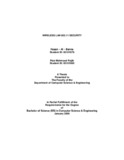| dc.contributor.advisor | Kazi, Ms. Sadia Hamid | |
| dc.contributor.author | Hasan-Al-Banna | |
| dc.contributor.author | Rajib, Riaz Mahmood | |
| dc.date.accessioned | 2010-10-13T06:34:49Z | |
| dc.date.available | 2010-10-13T06:34:49Z | |
| dc.date.copyright | 2008 | |
| dc.date.issued | 2008-01 | |
| dc.identifier.other | ID 03101078 | |
| dc.identifier.other | ID 03101060 | |
| dc.identifier.uri | http://hdl.handle.net/10361/493 | |
| dc.description | This thesis report is submitted in partial fulfillment of the requirements for the degree of Bachelor of Science in Computer Science and Engineering, 2008. | en_US |
| dc.description | Cataloged from PDF version of thesis report. | |
| dc.description | Includes bibliographical references (page 62-64). | |
| dc.description.abstract | When the wireless communications is coming to the offices and the homes, there are
some new security issues to be taken care of. Today we have continuously growing
markets for the wireless LANs, but there is big black hole in the security of this kind of
networks. Companies without controlled doors cannot ensure the security and safety of
their employees, nor can they prevent piracy and theft. Networks without controlled
access cannot guarantee the security or privacy of stored data, nor can they keep network
resources from being exploited by hackers. In our thesis we are giving an overview of the
security functions and threats specified in one wireless LAN standard, namely in the
IEEE 802.11.
The IEEE 802.11 is one of the very first wireless local area network standards that is
currently widely deployed. Much research has been done on the IEEE 802.11 wireless
network standard and the standard is known for its insecurity. Several reports have
addressed the 802.11-based network vulnerabilities mainly for its lack of authentication.
This thesis aims to improve the IEEE 802.11 standard by analyzing the security
mechanisms the standard provides. The IEEE 802.11 standard provides basic security
mechanisms such as the wired equivalent protocol, an encryption protocol, and the media
access based access control list, which is essentially a list of legitimate clients. Attackers
may easily penetrate these IEEE 802.11 basic security mechanisms.
I did not perform any testing of the attack solutions. Successors of this thesis project
should implement the attack and test out solutions. | en_US |
| dc.description.statementofresponsibility | Hasan–Al–Banna | |
| dc.description.statementofresponsibility | Riaz Mahmood Rajib | |
| dc.format.extent | 64 pages | |
| dc.language.iso | en | |
| dc.publisher | BRAC University | en_US |
| dc.rights | BRAC University thesis are protected by copyright. They may be viewed from this source for any purpose, but reproduction or distribution in any format is prohibited without written permission. | |
| dc.subject | Computer science and engineering | |
| dc.title | Wireless LAN 802.11 security | en_US |
| dc.type | Thesis | en_US |
| dc.contributor.department | Department of Computer Science and Engineering, BRAC University | |
| dc.description.degree | B. Computer Science and Engineering | |

